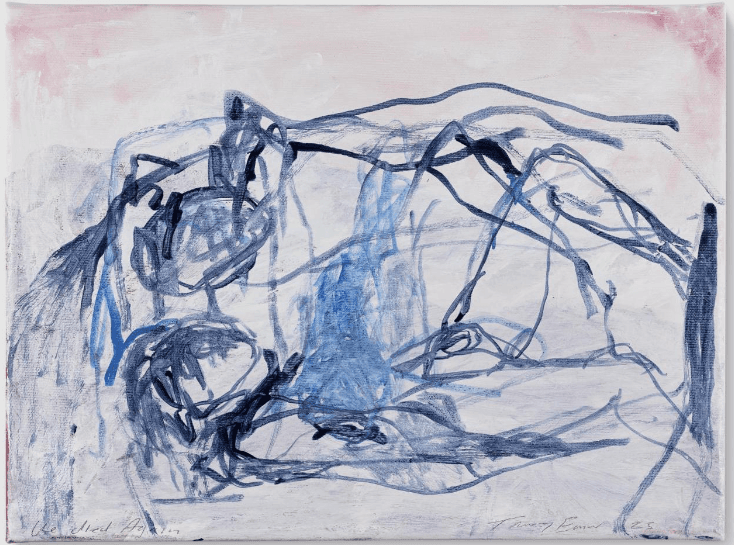Painter Tracey Emin, Who Survived a Terminal Cancer Diagnosis, Excavates the Intertwining of Love and Death in ‘Lover’s Grave’
Her work has always been about this precarious balance between the physical and the metaphysical, of raw carnal intent colliding head-on with life’s fleetingness and fragility.

Tracey Emin: ‘Lover’s Grave’
White Cube Gallery, 1002 Madison Avenue, New York, NY
Until January 15, 2024
For Tracey Emin, the personal and artistic have always been intwined. A member of the renegade group of the YBA, or young British artists, she dragged her unmade bed from her flat into a London gallery in 1990, causing a sensation. A second piece, “Every Person I have Ever Slept With,” featured a dome tent decorated with the embroidered names of individuals she had shared a bed with.
Ms. Emin, in other words, has always been a flagrantly open book, an artist who has lived dangerously out loud. Confessional, provocative, raw, contrarian, confrontational, all of these qualities have defined her work and career in ways that have both confounded and won over critics.
Her new exhibit at White Cube, which is her first major American show in more than eight years, speaks to a radically different chapter of her life. A short year after being awarded Britain’s Turner prize in 2019, she received a terminal cancer diagnosis.
“I had gone a period of ten years without any real physical contact,” she told a recent audience with her usual disarming frankness. “A real drought of intimacy. And one night I woke up and painted this canvas of lovers entwined in bed. Someone later remarked it looked like two lovers in a grave. I must have rebelled against it internally because I painted over it with this great abstract thing.”
Later, however, Ms. Emin fell madly in love and then received a diagnosis of bladder cancer and was given six months to live. “The doctor told me I couldn’t even get a dog. That’s how I knew it was serious,” she recalls.
The theme of both love and death and the lover’s grave, resurfaced. After radical surgery, which removed her bladder, uterus, lymph nodes, and a section of her intestine, Ms. Emin found herself facing an arduous recovery. A miraculous recovery but one fraught with tremendous challenges.
Luckily for the art world, however, art is the medium through which Ms. Emin addresses her trauma. This new collection of twenty-six paintings proves that she has, with her usual formidable resilience, returned with a vengeance.
Consisting of figures entwined in bed, the paintings exhaustively excavate the theme of the “lover’s grave.” The couples in these engaging works twist and entwine in various acts of intimacy, but she is adamant that sex is not the primary subject here.
“These paintings are not about sex,” she states flatly. “They are about love and mortality, the ideas around love and sex. I’m addressing that feeling of ‘I’m so in love with the other person I could happily die in their arms.’ I was also thinking of lovers buried side by side, as we find throughout history, of a couple being entwined for eternity.”
The figures in these paintings are often partially unresolved, tangles of spidery lines that coalesce into figures even as they appear to be in restless movement. However irresolute they can be, sometimes with limbs dissolving into thin air, they remain stubbornly present. The canvas becomes a viscous medium where the figures haunt the surface over the span of time.
Ms. Emin has often juxtaposed restless, passionate, lines and thin washes of color that flood or drip down the painting’s surface like a veil of tears. In others, she places them against blocks of red or rose that anchor them in space. She is adept at using a potent mix of color, line, and negative space, keeping the palette austere and limited. It imbues each work with an unlocatable, almost sinister aura.
Yet her work has always been about this precarious balance between the physical and the metaphysical, of raw carnal intent colliding head-on with life’s fleetingness and fragility. She meets this contradiction fearlessly in work after work. It is what gives these paintings their power and fierce vulnerability.
In her earlier paintings, Ms. Emin has shown a tendency to almost concede defeat to darkness, especially when addressing the tragedies of her young life. This new series of paintings is less dark and more contemplative, tender even. It’s as if she has finally come to gracious terms with her turbulent past.
“I believe this is the most important show of my life,” she said. “But I’m also at much more at peace with what I’m doing. Apart from my love life and apart from my health, I’ve never been so happy.”

